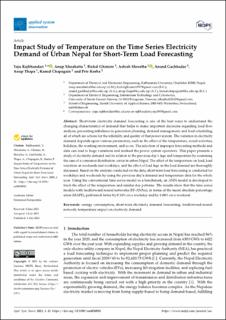| dc.contributor.author | Rajbhandari, Yaju | |
| dc.contributor.author | Marahatta, Anup | |
| dc.contributor.author | Ghimire, Bishal | |
| dc.contributor.author | Shrestha, Ashish | |
| dc.contributor.author | Gachhadar, Anand | |
| dc.contributor.author | Thapa, Anup | |
| dc.contributor.author | Chapagain, Kamal | |
| dc.contributor.author | Korba, Petr | |
| dc.date.accessioned | 2022-03-18T11:25:52Z | |
| dc.date.available | 2022-03-18T11:25:52Z | |
| dc.date.created | 2022-01-22T12:58:20Z | |
| dc.date.issued | 2021 | |
| dc.identifier.citation | Rajbhandari, Y., Marahatta, A., Ghimire, B., Shrestha, A., Gachhadar, A., Thapa, A., Chapagain, K. & Korba, P. (2021). Impact Study of Temperature on the Time Series Electricity Demand of Urban Nepal for Short-Term Load Forecasting. Applied System Innovation, 4(3), Artikkel 43. | en_US |
| dc.identifier.issn | 2571-5577 | |
| dc.identifier.uri | https://hdl.handle.net/11250/2986174 | |
| dc.description.abstract | Short-term electricity demand forecasting is one of the best ways to understand the changing characteristics of demand that helps to make important decisions regarding load flow analysis, preventing imbalance in generation planning, demand management, and load scheduling, all of which are actions for the reliability and quality of that power system. The variation in electricity demand depends upon various parameters, such as the effect of the temperature, social activities, holidays, the working environment, and so on. The selection of improper forecasting methods and data can lead to huge variations and mislead the power system operators. This paper presents a study of electricity demand and its relation to the previous day’s lags and temperature by examining the case of a consumer distribution center in urban Nepal. The effect of the temperature on load, load variation on weekends and weekdays, and the effect of load lags on the load demand are thoroughly discussed. Based on the analysis conducted on the data, short-term load forecasting is conducted for weekdays and weekends by using the previous day’s demand and temperature data for the whole year. Using the conventional time series model as a benchmark, an ANN model is developed to track the effect of the temperature and similar day patterns. The results show that the time series models with feedforward neural networks (FF-ANNs), in terms of the mean absolute percentage error (MAPE), performed better by 0.34% on a weekday and by 8.04% on a weekend. | en_US |
| dc.language.iso | eng | en_US |
| dc.rights | Navngivelse 4.0 Internasjonal | * |
| dc.rights.uri | http://creativecommons.org/licenses/by/4.0/deed.no | * |
| dc.title | Impact Study of Temperature on the Time Series Electricity Demand of Urban Nepal for Short-Term Load Forecasting | en_US |
| dc.type | Journal article | en_US |
| dc.type | Peer reviewed | en_US |
| dc.description.version | publishedVersion | en_US |
| dc.rights.holder | © 2021 by the authors. | en_US |
| dc.source.volume | 4 | en_US |
| dc.source.journal | Applied System Innovation | en_US |
| dc.source.issue | 3 | en_US |
| dc.identifier.doi | https://doi.org/10.3390/asi4030043 | |
| dc.identifier.cristin | 1987749 | |
| dc.source.articlenumber | 43 | en_US |
| cristin.ispublished | true | |
| cristin.fulltext | original | |
| cristin.qualitycode | 1 | |

